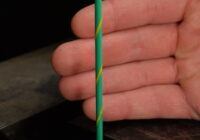
Aug 30, 2022
Solid vs. Stranded Wire
In the world of wiring, solid and stranded wire are both highly capable options. The choice comes down to your application. Each kind of wire excels in different areas, and using the right one can make the difference between a successful installation and one that quickly deteriorates.
What is Solid Wire?
Solid copper stranding means that there is a single strand of copper acting as the conductor. Common sizes of THHN wire — thermoplastic, high-heat resistant and nylon-coated — that use solid stranding are 14, 12 and 10 American Wire Gauge (AWG). Romex® NM-B cables and Underground Feeder Cable (UF-B) also use solid wire for the 14, 12 and 10 AWG cables.
A solid wire is heavy and thick, with good durability. They can handle more movement and environmental stressors. Since the copper wire is completely solid, it also helps deliver higher currents.
Contractors, electricians and installers use these sizes of electrical wire in homes and buildings. They want the cables to be stiff instead of flexible so that they hold their form during installation. In contrast, an extension cord is manufactured to be flexible so the user can handle it more easily on a daily basis.
What is Stranded Wire?
Stranded wires use multiple smaller wires and wind them together to get the same diameter as a solid strand. For instance, instead of using a single 10 AWG solid strand of copper, you could also get a 10 AWG wire with 19 strands. Obviously, those 19 strands are not all 10 AWG, or the cable would be much larger in diameter.
Manufacturers calculate how many strands of which gauge will offer equivalent performance to a 10 AWG solid wire. That way, both diameters of copper, solid or stranded, exert the same amount of current. You’ll find stranded wire labeled with two numbers. The first refers to the number of strands, and the second refers to the gauge of each strand. A 7/30 cable would have seven strands of 30 AWG each.
These thin, compressed strands of wire are typically insulated with a non-conductive material. Their biggest benefit is that they’re easy to route through complicated geometries and can wind into small or intricate spaces, usually indoors.
What is Flexible Stranding?
Typically, electrical wire used in homes or buildings does not come in a flexible option because the cables are installed and never touched again. However, extension cords and power cables are uncoiled to be used for the day and coiled back onto the reel for later use. Generator cables and welding cables come to mind as flexible cables with very thin stranding.
If you need a flexible cable, we can upgrade your electrical wire to a power cable. Just remember that power cables have a lot of design involved in them for outdoor wear and tear that feed into the price, such as flexible stranding and thick rubber insulation.
Solid vs. Stranded Wire: Which Should You Use?
Neither solid or stranded wire is better than the other. The right one simply depends on your application. Stranded wires are typically used only for indoor applications that won’t face much continuous flexing, particularly if they’re going in a cramped or complicated space. You’ll commonly see solid wires in infrastructure and outdoor installations that require more durability.
Here are some of the ways stranded and solid wire differ:
- Routing: With its increased flexibility, stranded wire can twist and turn through complex installations and obstacles.
- Capacity and distance: A stranded wire introduces more surface area on the conductors, creating less space for the current to travel. Without this limitation, solid wires can handle higher load capacities and avoid voltage drops across long distances.
- Flexibility: Stranded cables can twist and turn into more places, and certain patterns can stand up to more flexing over time. Solid wires perform better in applications with more vibration or movement.
- Cost: Since stranded wire has a more complicated manufacturing process, they tend to be more expensive.
- Heat production: A stranded wire has air gaps between the conductors, which allows heat to dissipate. These gaps can help maintain lower temperatures.
- Corrosion: The increased surface area of a stranded wire creates more opportunities for the metal to corrode. Solid wire can better avoid corrosion.
Get Solid and Stranded Wire From WesBell Wire and Cable
Whether your next project calls for stranded or solid wire, WesBell Electronics has a range of solutions. We’re the go-to provider for electrical wiring and preparation services, like wire cutting, twisting and harness assembly.
If you’re not sure which kind of wire is right for your application, our knowledgeable team is happy to help you find one. Explore our wide selection of wire products online!








